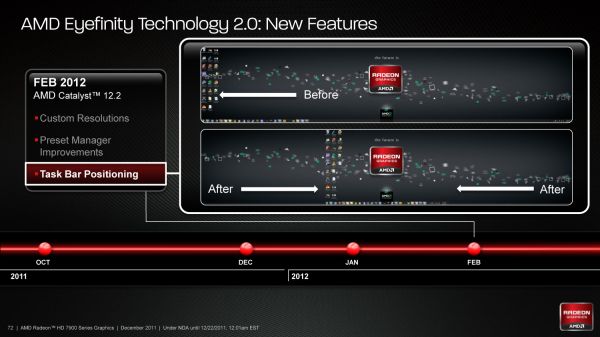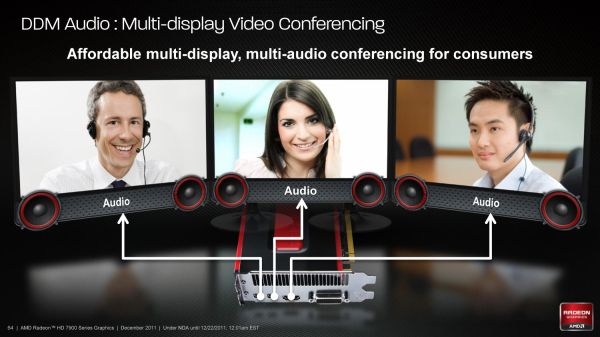AMD Radeon HD 7970 Review: 28nm And Graphics Core Next, Together As One
by Ryan Smith on December 22, 2011 12:00 AM EST- Posted in
- GPUs
- AMD
- Radeon
- ATI
- Radeon HD 7000
Display Tech: HD3D Eyefinity, MST Hubs, & DDM Audio
With the launch of the HD 5000 series back in 2009 AMD managed to get the drop on everyone, press and NVIDIA alike. Eyefinity, AMD’s Single Large Surface technology, came out of virtually nowhere thanks to a carefully orchestrated development plan that ensured very few people even within AMD knew about it. As a result of everything that was leaked ahead of time Eyefinity was not, making it AMD’s big eye catcher for the 5000 series.
As what was to be the first piece of the much dreamed about holodeck, AMD has been steadily working on it since 2009 in order to improve the experience even within their existing hardware by adding support for such features as bezel compensation and combining CrossFire with Eyefinity. For AMD it’s a feature of great importance even if end user adoption is still limited.
For the Southern Islands family AMD isn’t going to be pulling quite the rabbit out of their hat this time when it comes to displays. Southern Islands’ new display feature will be Discrete Digital Multi-Point Audio (which we’ll get to in a moment), but this doesn’t mean that AMD hasn’t continued to work on Eyefinity. Since October AMD has been engaged in an initiative they’re calling “Eyefinity Technology 2.0”, which is going to be pushed as a big part of the Southern Islands launch even though these are software improvements that will benefit all cards.
So what is Eyefinity Technology 2.0 composed of? We’ve already seen several new features starting with Catalyst 11.10, such as 5x1 portrait and landscape support and flexible bezel compensation support. The next step is going to be integrating Stereo 3D (or as AMD likes to call it, HD3D) into the mix, similar to how NVIDIA has 3D Vision Surround. Catalyst 11.12 introduced the ability to use HD3D with an Eyefinity display setup, and Catalyst 12.1 (preview out now) added support to do that in a CrossFire configuration. The final step is going to be with Catalyst 12.2 in February, which will add support for custom resolutions and the ability to relocate the Windows task bar to an arbitrary screen, two features that users have been asking about for quite some time. Again, all of these improvements are driver side, but they are a major component of AMD’s marketing for Southern Islands.
Speaking about Eyefinity, one issue that comes up time and time again is Multi Stream Transport (MST) hubs. We were introduced to MST hubs back with the launch of the 6800 series, which allowed a single DP 1.2 port to drive up to 4 monitors by taking advantage of the high bandwidth of DP1.2 and embedding transport streams for several monitors into the signal. The purpose of MST hubs was so that users could use several monitors with a regular Radeon card, rather than needing an exotic all-DisplayPort “Eyefinity edition” card as they need now.
But as many of you have asked me about, several deadlines for MST hubs have come and gone, including the latest deadline which was supposed to be by the end of this year. As with active DP adaptors this is largely out of AMD’s hands since they don’t produce the hardware, but they have been continuing to prod their partners on the issue. The latest deadline from AMD isn’t rosy – summer of 2012 – but they seem more confident of this deadline than deadlines in the past. Not that another half-year wait will be of any comfort for users who have been looking for MST hubs for the better part of the year, but at least it provides some idea on when to expect them.
Last, but certainly not least on the display technologies front is AMD’s new feature for Southern Islands, Discrete Digital Multi-Point Audio (DDMA). It’s a mouthful of a name but the concept is rather simple: it’s the next step in audio output from a video card. Video cards have been able to output audio for a few years now via HDMI, and more recently DisplayPort gained the ability. However GPUs have been limited to streaming audio to a single device, be it a monitor, TV, or receiver. With DDMA GPUs can send audio to multiple devices, and AMD is looking at how to put that ability to work.
The most basic use for being able to send audio to multiple devices is to individually address the speakers of each device, which is the cornerstone of AMD’s proposed use cases. Fundamentally AMD is looking at applications that involve matching audio streams to the monitor the relevant application is on – move a video player from your center monitor to your left monitor, and the audio from that video player should also move from the speakers on the middle monitor to the speakers on the left monitor. What can you do with speakers that are mapped to monitors? That’s what AMD wants to find out.
Being realistic for a moment, the 7970 isn’t going to be the card that sells this feature, as it’s a $550 gamer video card. Gamers are using dedicated 2.1/5.1/7.1 audio systems or headphones for surround sound, and while AMD does have a proposed multi-tasking use case for this it’s not very convincing. DDMA will become much more important on future lower end cards as those are the cards that go into family desktops, workstations, and the like. Thus the killer app for this feature (and certainly AMD’s best prepared scenario) is for video conferencing where each attendee is mapped to a monitor, and with DDMA a set of speakers on that monitor. AMD’s partner Oovoo is working on just such a system though it’s still early in development.












292 Comments
View All Comments
haukionkannel - Thursday, December 22, 2011 - link
Well, 7970 and other GCN based new cards are not so much driver depended as those older radeons. So the improvements are not going to be so great, but surely there will be some! So the gap between 580 or 6970 vs 7970 is going to be wider, but do not expect as big steps as 6970 got via new sets of drivers.Ryan Smith - Thursday, December 22, 2011 - link
This is actually an excellent point. Drivers will still play a big part in performance, but with GCN the shader compiler in particular is now no longer the end all and be all of shader performance as the CUs can do their own scheduling.CeriseCogburn - Thursday, March 8, 2012 - link
I hate to say it but once you implement a 10% IQ cheat, it's though to do it again and get away with it again in stock drivers.I see the 797x has finally got something to control the excessive shimmering... that's about 5 years of fail finally contained...that I've more or less been told to ignore.... until the 100+ gig zip download here... to prove amd has at least finally dealt with one IQ epic fail... (of course all the reviewers claim there are no differences all the time - after pointing out the 10% cheat, then forgetting about it, having the shimmer, then "not noticing it in game" - etc).
I'm just GLAD amd finally did something about that particular one of their problems.
Halleluiah !
Now some PhysX (fine bullet or open cl but for pete sakes nvidia is also ahead on both of those!) and AA working even when cranking it to 4X plus would be great... hopefully their new arch CAN DO.
If I get a couple 7970's am I going to regret it is my question - how much still doesn't work and or is inferior to nvidia... I guess I'll learn to ignore it all.
IceDread - Thursday, December 22, 2011 - link
It's a good card, but for me it's not worth it to upgrade from a 5970 to a 7970. Looks like that would be about the same performance.Scali - Thursday, December 22, 2011 - link
This is exactly the reason why I made Endless City available for Radeons:http://scalibq.wordpress.com/2010/11/25/running-nv...
Could you run it and give some framerate numbers with FRAPS or such?
Boissez - Thursday, December 22, 2011 - link
What many seem to be missing is that it is actually CHEAPER than the current street prices on the 3GB-equiped GTX 580. IOW it offers superior performance, features, thermals, etc. at a lower price than current gen at a lower price.What AMD should do is get a 1.5 GB model out @450$ ASAP.
SlyNine - Thursday, December 22, 2011 - link
Looks like I'll be sticking with my 5870. I upgraded from 2 8800GT's ( that in SLI never functioned quite right because they were hitting over 100C ever with after market HSF) and enjoyed over 2x the performance.When I upgraded from a 1900XT to the 8800GT's same thing, 800XT-1900XT, 9700pro - 800XT, 4200(nvidia)-9700pro. The list goes on to my first Geforce 256 card.
Whats the point, My 5870 is 2! generations behind the 7970 yet this would be the worst $per increase in performance yet. Bummer I really want something to drive a new 120hz monitor, if I ever get one. But then thats kinda dependent on whether or not a single GPU can push it.
Finally - Thursday, December 22, 2011 - link
Since when do top-of-the-line cards give you the best FPS/$?For the last few months the HD6870+HD6850 were leading all those comparisons by quite some margin. The DH7970 will not change that.
SlyNine - Thursday, December 22, 2011 - link
If you read my post, you will notice that I'm compairing it to the improvments I have paid for in the past.40-60% Better than a 2 YO 5870 Is much worse than I have seen so far. Considering that its not just one generation but 2 generations beyond and for 500+$ to boot. This is the worst upgrade for the cost I have seen.....
SlyNine - Thursday, December 22, 2011 - link
The 6870 would not lead the cost per upgrade in performance at all, It would be in the negitives for me.